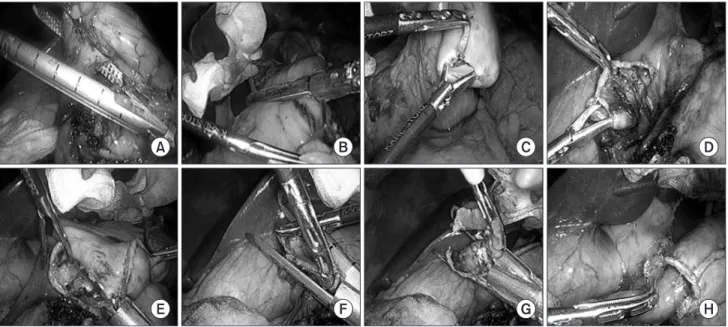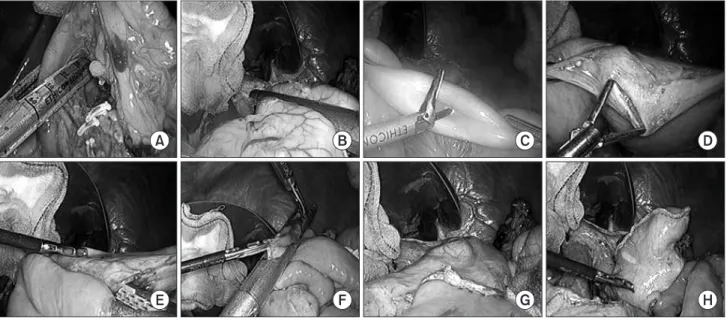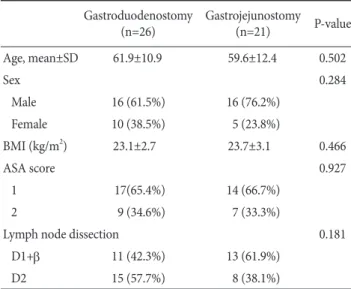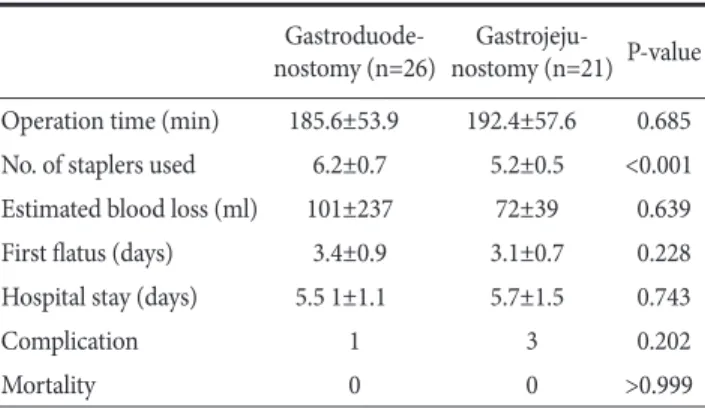Intracorporeal Anastomosis Using Linear Stapler in Laparoscopic Distal Gastrectomy: Comparison between
Gastroduodenostomy and Gastrojejunostomy
Hak Woo Lee1, Hyoung-Il Kim1, Ji Yeong An1, Jae-Ho Cheong1, Kang Young Lee1,2, Woo Jin Hyung1,2,3, and Sung Hoon Noh1,3
1Department of Surgery, 2Robot and MIS Center, and 3Brain Korea 21 Project for Medical Science, Yonsei University College of Medicine, Seoul, Korea
Purpose: Intracorporeal anastomosis during laparoscopic gastrectomy is becoming increasingly prevalent. However, selection of the anastomosis method after laparoscopic distal gastrectomy is equivocal because of a lack of technical feasibility and safety. We compared intracorporeal gastroduodenostomy with gastrojejunostomy using linear staplers to evaluate the technical feasibility and safety of intracor- poreal anastomoses as well as its’ minimally invasiveness.
Materials and Methods: Retrospective analyses of a prospectively collected database for gastric cancer revealed 47 gastric cancer pa- tients who underwent laparoscopic distal gastrectomy with either intracorporeal gastroduodenostomy or gastrojejunostomy from March 2011 to June 2011. Perioperative outcomes such as operation time, postoperative complication, and hospital stay were compared ac- cording to the type of anastomosis. Postoperative inflammatory response was also compared between the two groups using white blood cell count and high sensitivity C-reactive protein.
Results: Among the 47 patients, 26 patients received gastroduodenostomy, whereas 21 patients received gastrojejunostomy without open conversion or additional mini-laparotomy incision. There was no difference in mean operation time, blood loss, and length of post- operative hospital stays. There was no statistically significant difference in postoperative complication or mortality between two groups.
However, significantly more staplers were used for gastroduodenostomy than for gastrojejunostomy (n=6) than for gastroduodenostomy and (n=5).
Conclusions: Intracorporeal anastomosis during laparoscopic gastrectomy using linear stapler, either gastroduodenostomy or gastrojeju- nostomy, shows comparable and acceptable early postoperative outcomes and are safe and feasible. Therefore, surgeons may choose either anastomosis method as long as oncological safety is guaranteed.
Key Words: Laparoscopy; Gastrectomy; Billroth I operation; Billroth II operation
Correspondence to: Woo Jin Hyung
Department of Surgery, Yonsei University College of Medicine, 50, Yonsei-ro Seodaemun-gu, Seoul 120-752, Korea
Tel: +82-2-2228-2129, Fax: +82-2-313-8289 E-mail: wjhyung@yuhs.ac
Received September 30, 2011 Revised October 26, 2011 Accepted October 26, 2011
Copyrights © 2011 by The Korean Gastric Cancer Association www.jgc-online.org
This is an open-access article distributed under the terms of the Creative Commons Attribution Non-Commercial License (http://creativecommons.org/
licenses/by-nc/3.0) which permits unrestricted noncommercial use, distribution, and reproduction in any medium, provided the original work is properly cited.
Introduction
With the help of screening program for gastric cancer, the detection of early gastric cancer is increasing in Korea. In recent
years, more and more gastric cancer patients in Korea are diag- nosed as early gastric cancer.(1,2) Along with increased proportion of early gastric cancer, laparoscopic gastrectomy is also increasing because of its minimally invasiveness.(1) Along with the increase of endoscopic treatment of early gastric cancer, laparoscopic surgery is being a preferred option for early gastric cancer surgery. Thus, laparoscopy-assisted procedures for gastric cancer are becom- ing popular which results in an improved quality of life. However, laparoscopy assisted gastrectomy still requires an additional mini- laparotomy incision to perform the anastomosis. Furthermore,
making anastomosis through a mini-laparotomy may diminish the potential minimally invasiveness, especially for obese patients for whom requires longer mini-laparotomy.
By eliminating the mini-laparotomy, intracorporeal anastomo- sis may improve cosmetic result as well as clinical outcomes such as earlier bowel function recovery.(3) Various types of intracor- poreal anastomosis after distal gastrectomy have been introduced and reported to be a safe and simple method.(3-5) However, there has been no report that compared the different types of the in- tracorporeal anastomosis method in terms of their postoperative outcomes. We compared intracorporeal gastroduodenostomy with gastrojejunostomy to evaluate the technical feasibility and safety of intracorporeal anastomoses as well as it’s minimally invasiveness.
Materials and Methods
1. Patients
A retrospective review of a prospectively collected database for gastric cancer revealed 47 gastric cancer patients who underwent laparoscopic distal gastrectomy from March 2011 to June 2011.
All these 47 laparoscopic gastrectomies were performed with ei- ther intracorporeal gastroduodenostomy or gastrojejunostomy.
These 47 patients were divided into two groups for comparison:
gastroduodenostomy (n=26) and gastrojejunostomy (n=21) group.
Patient demographics, underlying diseases, data on surgery, data on
preoperative and postoperative monitoring including complications and length of hospital stays, and pathologic results were compared between the two groups.
All the operations were performed by a single surgeon with same operative methods at the Department of Surgery, Yonsei Uni- versity College of Medicine. In our institution, minimally invasive surgery for gastric cancer was performed on patients, who were diagnosed as having early stage gastric cancer preoperatively (in other words, when there is no evidence of tumor invasion to serosa of stomach wall or extraperigastric lymph node metastasis) with the exception of those who with lesions for endoscopic mucosal resec- tion. All patients eligible for minimally invasive surgery were in- formed about the operative procedure, as well as open gastrectomy.
Patients with early stage gastric cancer were allowed to choose the type of operation, either minimally invasive or open surgery. All patients provided a written informed consent for an operation at the time of surgery.
2. Surgical procedures
All patients in this study underwent laparoscopic distal gastrec- tomy with either gastroduodenostomy or gastrojejunostomy includ- ing D1+β or D2 lymphadenectomy according to the rules of the Japanese Research Society for Gastric Cancer.(6) Detailed descrip- tion of surgical procedure for laparoscopic distal gastrectomy es- pecially for lymph node dissection was presented elsewhere.(7) To
Fig. 1. Intracorpoeal gastroduodenostomy using linear staplers. (A) Intraoperative image showing resection of the duodenum. (B) Resection of the stomach. (C) Creation of entry hole along the edge of the greater of the remnant stomach. (D) Creation of entry hole at medial end of the duode- num. (E) A linear stapler is placed in between the remnant stomach and the duodenum and fi red. (F) First fi ring of a linear stapler to close the com- mon entry hole. (G) Second fi ring of a linear stapler to close the common entry hole. (H) Stapler line of anastomosis aft er reconstruction.
detect the intraluminal lesion which was marked with endoscopic clips the before the operation and to decide the resection line, in- traoperative plain radiography was taken after applying the clips on the greater and the lesser curvature of the stomach.(8) Then intesti- nal continuity was restored either gastroduodenostomy or gastroje- junostomy based on the tumor location. Gastroduodenostomy was performed whenever it was possible to get the tumor-free margins.
3. Gastroduodenostomy (Fig. 1)
Intracorporeal gasrtoduodestomy was performed using linear staplers, similar to so-called Delta-shape anastomosis.(3-5) After the dissection of the infrapyloric area and making a window just distal to pylorus, the duodenum is transected from posterior to the anterior wall using a 45 mm endoscopic linear stapler with blue cartilage which was inserted through a port in the left flank area.
After completing the all lymph node dissection, stomach was re- sected from greater curvature to lesser curvature by applying two 60 mm endoscopic linear staplers with blue cartilage through a port in the left flank area. After resection, the specimen was placed in a plastic bag and placed at lower abdominal cavity. Small holes were created along the edge of the grater curvature of the remnant stom- ach and the medial edge of the duodenum. A 45 mm endoscopic linear stapler with blue cartilage was placed between the remnant stomach and duodenum (cartilage in the stomach and anvil into the duodenum), and then the posterior wall of the remnant stom- ach and the posterior wall of the duodenum were approximated by
the stapler. By firing the stapler, the common channel between the stomach and the duodenum was made. The entry hole left was also closed by linear staplers. When closing the common entry hole, previous stapled duodenal stump was also removed to secure the blood supply to the duodenum.
4. Gastrojejunostomy (Fig. 2)
Intracorporeal gastrojejunostomy was performed by a side-to- side fashion using linear staplers. Small holes were created at the grater curvature of the remnant stomach and the antimesenteric border of the jejunum. A 60 mm endoscopic linear stapler with blue cartilage was placed between the remnant stomach and jejunum (cartilage in the stomach and anvil into the jejunum), and then the greater curvature of the remnant stomach and the antimesenteric border of the jejunum were approximated by the stapler through a left flank port. The length of the afferent loop was made as short as possible unless tension was made. The common entry hole was closed by a 60 mm linear stapler through a right flank port.
5. Postoperative management
After the operation, a standardized postoperative care protocol was applied to both groups as follows. When patients were toler- able, sips of water were permitted from postoperative day 2, a liquid diet was given on postoperative day 3, and a soft diet was started on postoperative day 4. After 1 day of a soft diet without complica- tions, patients were encouraged to be discharged.
Fig. 2. Intracorporeal gastrojejunostomy using linear staplers. (A) Intraoperative image showing resection of the duodenum. (B) Resection of the stomach and stapler line of artifi cial lesser curvature. (C) Creation of entry hole on the antimesenteric border of the jejunum. (D) Creation of entry hole on the greater curvature side of the remnant stomach. (E) A linear stapler is placed in between the remnant stomach and the jejunum. (F) Clo- sure of the common entry hole using a linear stapler. (G) Anterior stapler line of the anastomosis. (H) Posterior stapler line of the anastomosis.
6. Statistical analysis
We performed all statistical analyses using the Statistical Pack- age for Social Science (SPSS) version 18.0 for Microsoft Windows (SPSS Inc., Chicago, IL, USA). Student t-test was used to analyze the mean differences in continuous variables between the groups.
Mixed model analysis was use to compare the laboratory results of white blood cell count and high sensitivity C-reactive protein be- tween the groups. Chi-square test was used to compare categorical variables. All P-values less than 0.05 were regarded as statistically significant.
Results
All 47 gastric cancer patients in this study underwent lapa- roscopic distal gastrectomy with either gastroduodenostomy or gastrojejunostomy without open conversion or additional mini- laparotomy incision. Patients’ characteristics are shown in Table 1. There was no significant difference in patients’ characteristics such as age, gender, body mass index and the American Society of Anesthesiologist score between two groups. Pathologic results of two groups such as histology, tumor size, location of tumor, depth of invasion and number of retrieved lymph nodes were not statisti- cally significant as shown in Table 2. Only lymph node metastasis showed statistical difference, however tumor stage based on 7th American Joint Committee on Cancer Classification was not statis- tically significant.
The mean operation time of intracorporeal gastroduodenostomy
group was 185.6 minutes compared to 192.4 minutes in intracor- poreal gastrojejunostomy group. The estimated blood loss was 101 ml in intracorporeal gastroduodenostomy group and 72 ml in intracorporeal gastrojejunostomy group. Significantly more staplers were used for gastroduodenostomy than for gastrojejunostomy. The mean number of staplers used was 6 with a range of 5 to 8 in in- tracorporeal gastroduodenostomy group while it was 5 with a range of 5 to 7 in intracorporeal gastrojejunostomy group (Table 3).
There were no intraoperative complications related to anas- tomosis. In terms of postoperative complication, one patient who received intracorporeal gastroduodenostomy experienced melena after the operation which resolved spontaneously. There were 3 patients who experienced postoperative complications after intra- corporeal gastrojejunostomy, 1 patient with wound abscess and 2 patients with postoperative atelectasis. Regarding the inflammatory
Table 1. Comparison of clinical characteristics Gastroduodenostomy
(n=26)
Gastrojejunostomy (n=21) P-value
Age, mean±SD 61.9±10.9 59.6±12.4 0.502
Sex 0.284
Male 16 (61.5%) 16 (76.2%)
Female 10 (38.5%) 5 (23.8%)
BMI (kg/m2) 23.1±2.7 23.7±3.1 0.466
ASA score 0.927
1 17(65.4%) 14 (66.7%)
2 9 (34.6%) 7 (33.3%)
Lymph node dissection 0.181
D1+β 11 (42.3%) 13 (61.9%)
D2 15 (57.7%) 8 (38.1%)
SD = standard deviation; BMI = body mass index; ASA = American Society of Anesthesiologist.
Table 2. Comparison of pathologic features Gastroduode- nostomy (n=26)
Gastroduode-
nostomy (n=21) P-value Histology 0.980 Diff erentiated 10 (38.5%) 8 (38.1%)
Undiff erentiated 16 (61.5%) 13 (61.9%)
Size (mm) 23.4 32.8 0.064
Location 0.668
Mid 6 (23.1%) 6 (28.6%)
Low 20 (76.9%) 15 (71.4%)
Depth of invasion 0.215
T1 26 (100%) 17 (80.9%)
T2 0 1 (4.8%)
T3 0 3 (14.3%)
Nodal classifi cation 0.031
N0 26 (100%) 16 (76.2%)
N1 0 4 (19.0%)
N2 0 0
N3 0 1 (4.8%)
Retrieved LN no. 30.1±10.0 27.4±8.6
Stage 0.067
I 26 (100%) 17 (80.9%)
II 0 3 (14,3%)
III 0 1 (4.8%)
Resection margins
Proximal (mm) 52.3±29.4 56.8±28.7 0.609
Distal (mm) 51.2±28.0 54.2±30.8 0.741
LN = lymph node; no. = number.
response, the level of high sensitivity C-reactive protein and white blood cell count were not different between the two groups and the patterns of those were similar during the postoperative period.
The changes of high sensitivity C-reactive protein and white blood cell count during perioperative period showed similar patterns (Fig.
3). The mean length of hospital stays after the operation was 5.5 days in intracorporeal gastroduodenostomy group and 5.7 days in intracorporeal gastrojejunostomy group without statistical difference (Table 3).
Discussion
In this comparative study, postoperative outcomes after intra- corporeal anastomosis were comparable between gastroduodenos-
tomy and gastrojejunostomy, except that more staplers were used for gastroduodenostomy than for gastrojejunostomy. No intraop- erative problems related to anastomosis procedure were observed.
Postoperative complications in intracorporeal anastomosis using linear staplers were acceptable. Furthermore, complication related to anastomosis was only one conservatively managed intraluminal bleeding in gastroduodenostomy group.
In the initial period of laparoscopic surgery for gastric cancer, most of surgeons preferred extracorporeal anastomosis regardless of its type because extracorporeal anastomosis was more familiar and technically easy. However, mini-laparotomy incision is needed to perform extracorporeal anastomosis. Mini-laparotomy could cause difficulties in anastomosis due to limited view and working space which could lead to unnecessary injuries to structures around anastomosis.(3) Thus, extracorporeal anastomosis is not well fit for the concept of minimally invasive surgery. Recently, several reports of safety and feasibility of laparoscopic gastrectomy with intracorporeal anastomosis were introduced.(3-5,9) With technical advances in minimally invasive surgery, laparoscopic distal gastrec- tomy with intracorporeal anastomosis using linear stapler is likely to become more popular recently. In laparoscopic gastrectomy with intracorporeal anastomosis, anastomosis is performed with bet- ter view of the field and whole procedure can be observed, thus anastomosis can be done more safely and unnecessary manipula- tion of surrounded structures can be avoided. Surgical wound of intracorporeal anastomosis may result in better cosmetic outcomes because specimens can be retrieved through a smaller incision than Table 3. Comparison of surgical outcomes
Gastroduode- nostomy (n=26)
Gastrojeju-
nostomy (n=21) P-value Operation time (min) 185.6±53.9 192.4±57.6 0.685 No. of staplers used 6.2±0.7 5.2±0.5 <0.001 Estimated blood loss (ml) 101±237 72±39 0.639
First fl atus (days) 3.4±0.9 3.1±0.7 0.228
Hospital stay (days) 5.5 1±1.1 5.7±1.5 0.743
Complication 1 3 0.202
Mortality 0 0 >0.999
Values are mean±standard deviation; No. = number.
Fig. 3. (A) Changes of high sensitivity C-reactive protein aft er laparoscopic distal gastrectomy with intracorporeal gastroduodenostomy or gastro- jejunostomy. Th ere was no statistical diff erence between the anastomosis methods (Mixed model analysis, P=0.501). (B) Changes of white blood cell count aft er laparoscopic distal gastrectomy with intracorporeal gastroduodenostomy or gastrojejunostomy. Th ere was no statistical diff erence between the anastomosis methods (Mixed model analysis, P=0.864). Preop = preoperative; postop = postoperative; POD = postoperative day.
the mini-laparotomy for extracorporeal anastomosis.
For intracorporeal anastomosis, localization of tumor during surgery is utmost important. Unlike in extracorporeal anastomosis, surgeons cannot localize the tumor with their hands. As reported in other studies, preoperative endoscopic clipping or tattooing and intraoperative ultrasonography may be helpful to localize the tumor.
(10) In our series, preoperative endoscopic clipping was done and intraoperative plain x-ray was taken after applying the laparoscopic metallic clip at stomach wall to confirm the location.(8) After iden- tifying the location of tumor, surgeon decided whether to perform gastroduodenostomy or gastrojejunostomy. The proximal margin from the tumor in both type of anastomosis was all sufficient and there was no margin positive result in any of cases.
Another suggested concern for intracorporeal anastomosis was longer operation time. In this study, the operation time was 185.6 minutes for gastroduodenostomy and 192.4 minutes for gastro- jejunostomy. These operation times were comparable to that of operation time for extracorporeal anastomosis reported previously.
(3,11,12) Theoretically, if surgeons become proficient to perform intracorporeal anastomosis, operation will not be longer than extracorporeal anastomosis. Furthermore, operation time for in- tracorporeal anastomosis can be shorter than extracorporeal anas- tomosis, because time for making and closing mini-laparotomy is not needed.
In our institution, laparoscopic gastrectomy with intracorporeal gastrojejunostomy has been performed mostly whereas intracor- poreal gastroduodenostomy has been recently adopted. It has been suggested that gastrojejunostomy was associated with higher rate of complications and also higher risk of remnant cancer in the long- term.(13,14) However, gastroduodenostomy cannot be done if there is tension on the anastomosis. As shown in this study, postopera- tive outcomes were not different between gastroduodenostomy and gastrojejunostomy. Therefore, surgeon can choose any type of anastomosis when it is oncologically safe and technically feasible.
As far as we know, this study is the first report to compare the surgical outcomes of intracorporeal gastroduodenostomy and gas- trojejunostomy. Moreover, results in this study was not influenced by differences in surgeons’ technique, instrument used, or patient care protocol because all surgical procedures were performed with same anastomotic technique without any modification during a relatively short period of time. However, retrospective nature of analyses and no follow-up data hindered the comprehensive com- parison of outcomes related to anastomosis method. Thus more detailed and long-term comparative results such as times spent only
for the anastomosis and long-term anastomosis related problems such as stenosis and nutritional sequelae cannot be assessed. Also number of patients included was too small to analyze the difference of leakage rates between two procedures. Considering the limitation of retrospective analysis and small number of cases in this study, further evaluations with large number of cases and well designed prospective randomized study with long-term surgical outcomes would be necessary.
In conclusion, intracorporeal anastomosis during laparoscopic gastrectomy using laparoscopic linear stapler, gastroduodenostomy or gastrojejunostomy, showed comparable and acceptable early postoperative outcomes and they were safe and feasible. There- fore, surgeons may choose any type of anastomosis as long as the tumor-free margins were obtained.
Acknowledgments
This work was supported by a grant of the Korea Healthcare technology R&D project, Ministry of Health, Welfare, & Family Affairs, Republic of Korea (1020410).
References
1. Jeong O, Park YK. Clinicopathological features and surgical treatment of gastric cancer in South Korea: the results of 2009 nationwide survey on surgically treated gastric cancer patients.
J Gastric Cancer 2011;11:69-77.
2. Hyung WJ, Kim SS, Choi WH, Cheong JH, Choi SH, Kim CB, et al. Changes in treatment outcomes of gastric cancer surgery over 45 years at a single institution. Yonsei Med J 2008;49:409- 415.
3. Song KY, Park CH, Kang HC, Kim JJ, Park SM, Jun KH, et al.
Is totally laparoscopic gastrectomy less invasive than laparos- copy-assisted gastrectomy?: prospective, multicenter study. J Gastrointest Surg 2008;12:1015-1021.
4. Kanaya S, Gomi T, Momoi H, Tamaki N, Isobe H, Katayama T, et al. Delta-shaped anastomosis in totally laparoscopic Billroth I gastrectomy: new technique of intraabdominal gastroduode- nostomy. J Am Coll Surg 2002;195:284-287.
5. Kanaya S, Kawamura Y, Kawada H, Iwasaki H, Gomi T, Satoh S, et al. The delta-shaped anastomosis in laparoscopic distal gastrectomy: analysis of the initial 100 consecutive proce- dures of intracorporeal gastroduodenostomy. Gastric Cancer 2011;14:365-371.
6. Japanese Gastric Cancer Association. Japanese classification of gastric carcinoma - 2nd English edition - Gastric Cancer 1998;1:10-24.
7. Hyung WJ, Song C, Cheong JH, Choi SH, Noh SH. Factors infl uencing operation time of laparoscopy-assisted distal sub- total gastrectomy: analysis of consecutive 100 initial cases. Eur J Surg Oncol 2007;33:314-319.
8. Kim HI, Hyung WJ, Lee CR, Lim JS, An JY, Cheong JH, et al.
Intraoperative portable abdominal radiograph for tumor local- ization: a simple and accurate method for laparoscopic gastrec- tomy. Surg Endosc 2011;25:958-963.
9. Lee SW, Bouras G, Nomura E, Yoshinaka R, Tokuhara T, Nitta T, et al. Intracorporeal stapled anastomosis following laparoscopic segmental gastrectomy for gastric cancer: technical report and surgical outcomes. Surg Endosc 2010;24:1774-1780.
10. Hyung WJ, Lim JS, Cheong JH, Kim J, Choi SH, Song SY, et al.
Intraoperative tumor localization using laparoscopic ultraso- nography in laparoscopic-assisted gastrectomy. Surg Endosc 2005;19:1353-1357.
11. Lee HJ, Kim HH, Kim MC, Ryu SY, Kim W, Song KY, et al; Ko- rean Laparoscopic Gastrointestinal Surgery Study Group. Th e impact of a high body mass index on laparoscopy assisted gas- trectomy for gastric cancer. Surg Endosc 2009;23:2473-2479.
12. Song KY, Kim SN, Park CH. Laparoscopy-assisted distal gas- trectomy with D2 lymph node dissection for gastric cancer:
technical and oncologic aspects. Surg Endosc 2008;22:655-659.
13. Park DJ, Lee HJ, Kim HH, Yang HK, Lee KU, Choe KJ. Pre- dictors of operative morbidity and mortality in gastric cancer surgery. Br J Surg 2005;92:1099-1102.
14. Sah BK, Chen MM, Yan M, Zhu ZG. Gastric cancer surgery:
Billroth I or Billroth II for distal gastrectomy? BMC Cancer 2009;9:428.



